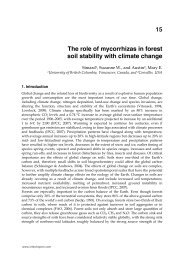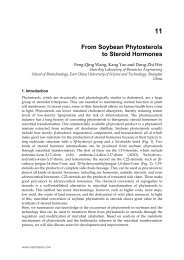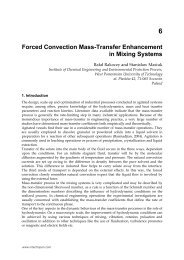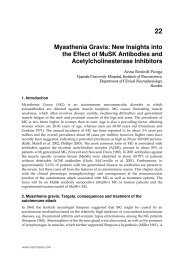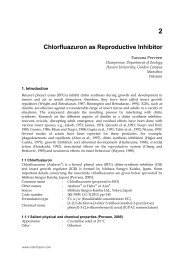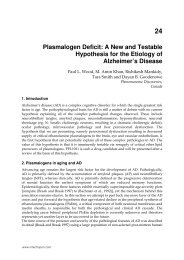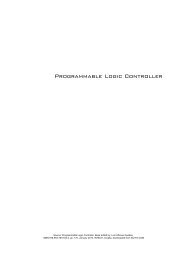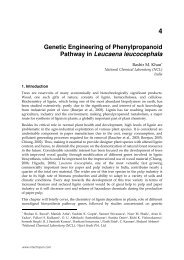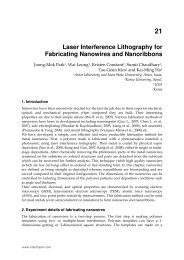Hemodialysis Vascular Access Dysfunction - InTech
Hemodialysis Vascular Access Dysfunction - InTech
Hemodialysis Vascular Access Dysfunction - InTech
You also want an ePaper? Increase the reach of your titles
YUMPU automatically turns print PDFs into web optimized ePapers that Google loves.
374<br />
Progress in <strong>Hemodialysis</strong> – From Emergent Biotechnology to Clinical Practice<br />
Wrap TM, (Angiotech Pharmaceuticals, Inc.; Vancouver, British Columbia, Canada), was<br />
initiated to study the effectiveness and safety of this therapy on primary AVG patency<br />
compared to a standard AVG. However, this study was recently suspended in 2009<br />
following a data safety monitoring review, due to an imbalance in the incidence of infections<br />
in one of the arms (either control or treatment). An alternative approach is the use of<br />
sirolimus eluting COLL-R® wraps (Covalon Technologies Ltd: Mississauga, Ontario,<br />
Canada). An initial Phase II study demonstrated primary unassisted AVG patency of 75%<br />
and 38% at 1 and 2 years respectively with these wraps 194.<br />
5.4.2 Endothelial cell loaded gel foam wraps<br />
The rationale behind the use of these wraps is that the endothelial cell (in addition to lining<br />
blood vessels) is also a “bioreactor” which produces a large number of beneficial mediators<br />
that reduces thrombosis, inflammation, stenosis, and increases lumen diameter. Initial<br />
experimental studies have documented a beneficial effect of endothelial cell loaded gel-foam<br />
wraps in porcine models of AV fistula and graft stenosis 195-198. A recent Phase II study (“V-<br />
HEALTH”) was able to demonstrate technical feasibility and safety in hemodialysis patients<br />
who received a “Vascugel®” wrap loaded with treated human aortic endothelial cells at the<br />
time of AVF or AVG placement 97. A phase III multi-center randomized-controlled study<br />
using the Vascugel® (Pervasis Therapeutics, Inc., Cambridge, MA) wraps in human AVGs is<br />
currently being designed.<br />
5.4.3 <strong>Vascular</strong> Endothelial Growth Factor D (VEGF-D) gene therapy<br />
In animal models of angioplasty induced restenosis, the delivery of adenoviral particles<br />
encoding for vascular-endothelial growth factor C to the site of vascular injury has been<br />
shown to trigger the release of nitric oxide and prostacyclin and reduce neointimal<br />
hyperplasia 199. Preliminary studies on the use of VEGF-D gene therapy (using a packaged<br />
adenoviral vector and a biodegradable local delivery device (collar) made of collagen<br />
wrapped at the venous anastomosis at the time of surgery), “Trinam ®” (Ark Therapeutics;<br />
London, UK), in patients receiving AVGs, have been able to document technical feasibility<br />
and safety. A phase III study using this technology was initiated in 2009 but terminated in<br />
2010 due to poor enrollment.<br />
5.4.4 Recombinant elastase PRT-201<br />
PRT-201 (Proteon Therapeutics; Waltham, MA) is a recombinant pancreatic elastase<br />
topically applied at the outflow vein at the time of surgery access creation which has been<br />
shown to result in both arterial and venous dilation and an increase in AVF blood flow in<br />
experimental models 200. The clinical benefit of this approach is the potential ability to<br />
enhance AVF maturation (through rapid vascular dilation) and prevent venous stenosis in<br />
AVGs. A phase II study using this novel technology is ongoing in the United States<br />
evaluating this therapy and whether or not it improves primary patency and cumulative<br />
survival in AVG and AVF, as well as safety.<br />
5.5 Endovascular stent therapy<br />
Endovascular vascular therapies (angioplasty or angioplasty with stent placement) remains<br />
the only true intervention available to treat vascular stenosis. The main advantage of stent<br />
therapy after angioplasty is a reduction in adverse remodeling. In dialysis access, placement<br />
www.intechopen.com




